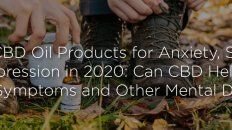As we age, we naturally develop joint pain, arthritis, and other age-related illnesses. While these disorders may be natural by-products of the aging process, they can still be incredibly painful to experience. In the past, many people turned to pain medication in order to treat chronic and acute pain. Unfortunately, many painkillers are highly addictive. Because of this, more people are looking for non-addictive options like cannabidiol (CBD).
Finding Alternative Solutions for Pain Management
In just 2016, there were 47,600 deaths from opioid overdoses. By 2018, an estimated 2 million people suffered from opioid abuse. Unfortunately, the number of opioid deaths has only been increasing over time. The 2017 rate of opioid deaths was six times higher than it was in 1999.
Many people develop opioid addiction after taking prescription drugs. They may use opioids to treat pain after surgery or a work-related injury. A number of people also take opioids for chronic pain and develop an addiction.
Seniors are also at risk of developing opioid abuse. While many news organizations have focused on adolescents and young adults, two recent reports have sounded the alarm about seniors and painkiller addiction. Millions of older Americans are now getting prescriptions for multiple opioids at once. Unsurprisingly, hundreds of thousands of seniors are ending up in the hospital with opioid-related problems. Older populations have more of a chance to suffer from chronic pain, so it makes sense that opioid addiction can be an issue.
An estimated 80 percent of seniors have multiple health conditions like depression, heart disease, and arthritis. Chronic pain is also common among seniors. Even though there are negative side effects and drug interactions, many seniors have to take opioids in order to cope with their pain. From 2010 to 2015, there was a 34 percent increase in opioid-driven inpatient hospital admissions for older adults. In addition, around 20 percent of seniors filled at least one prescription for opioids between 2015 to 2016.
How Does CBD Work?
When it comes to the opioid epidemic, there are two key facts that are indisputable. Seniors have a higher potential of dealing with some kind of acute or chronic pain. When that pain happens, they are at risk of developing substance abuse and negative side effects if they use opioids.
Because of this two-fold problem, seniors need an alternative option for treating pain. Instead of using opioids, seniors can use a natural medicine like CBD. Some CBD medications like Epidiolex have already been approved by the Food and Drug Administration (FDA). Because Epidiolex went through FDA trials to be approved, doctors already know that CBD is generally safe to use and does not have any potential for abuse.
CBD is just one of more than 100 different cannabinoids in cannabis. Many people are familiar with marijuana’s most popular cannabinoid, which is tetrahydrocannabinol (THC). Unlike THC, CBD can not cause any euphoria or high. Instead, it can help alleviate chronic pain, anxiety and insomnia.
CBD works by using the endocannabinoid system that exists within the central and peripheral nervous system. CBD uses CB1/CB2 receptors as well as many other targets to modulate and regulate perception of pain. While there are more clinical trials underway, scientists already know that CBD can help alleviate chronic pain. If you need an alternative to opioids, CBD is a good place to start. For more detailed information about why CBD works and what’s actually happening in your body when you take CBD, check our Dr. Bob’s work here.
Full-Spectrum CBD, Broad-Spectrum CBD and CBD Isolate
If you decide that you want to use CBD for pain management, you may need to figure out if you want to use full-spectrum CBD, broad-spectrum CBD or CBD isolate. The right type depends on what you are looking for and whether you are going to be drug tested. You may be able to heighten your pain relief through the entourage effect.
Full-Spectrum CBD
CBD isolate, full-spectrum CBD and broad-spectrum CBD are all created using different extraction methods. Extraction is basically the process that has to occur to turn a cannabis plant into cannabinoids like CBD. Full-spectrum CBD is unique because it carries a full profile of different terpenes and cannabinoids. Known as whole-plant CBD, full-spectrum CBD still contains trace amounts of THC because a wide array of cannabinoids are left in the finished product. While there is not enough THC to get you high, there may be enough THC to make you fail a drug test.
Broad-Spectrum CBD
Broad-spectrum CBD is a mid-range offering. It is ideal if you want more cannabinoids and terpenes than CBD isolate, but you do not want to fail a drug test. Basically, broad-spectrum CBD is full-spectrum CBD without the THC. It undergoes an extra layer of processing in order to take the THC out. The other cannabinoids and beneficial terpenes remain.
CBD Isolate
CBD isolate is pure CBD. It is refined so that all of the other cannabinoids and compounds are completely removed. This happens through a winterization process that also removes any waxes in the finished product. The final product is around 99 percent pure. If you are worried about a drug test, CBD isolate is the best choice.
The Entourage Effect
There is so much knowledge that scientists are still trying to gain about CBD and cannabis. While researchers have already started some clinical trials, people still do not know what dozens of different cannabinoids actually do. At the moment, many researchers believe that the cannabinoids in cannabis act synergistically in an entourage effect.
The entourage effect is the idea that all of the different compounds play off of each other. Basically, these compounds may create a greater effect together than the sum of their parts. Because of this, many people choose to take full-spectrum CBD or broad-spectrum CBD if they do not have to worry about passing a drug test.
Research on CBD and Pain Management
Today, many people are turning to CBD to help alleviate conditions like chronic pain. This supplement has been used for conditions ranging from anxiety to insomnia. Clinical studies in animals show that CBD can effectively reduce inflammation and pain. FDA trials for Epidiolex and other human trials show that CBD causes very few side effects and is tolerated well by the human body.
The Arthritis Foundation conducted a survey of 2,600 arthritis sufferers and found that 29 percent of the survey’s participants already used CBD to treat symptoms of arthritis. People who have chronic pain can add CBD to their treatment plan for pain relief. In addition to reducing pain, CBD can reduce the number of painkillers people have to take.
Tips for Using CBD
Before you begin using CBD, talk to your doctor first. CBD can potentially interact with prescription medications, so it is important to make sure that there are no drug interactions to watch out for. In addition, consider your administration method. While smoking or vaping CBD allows your body to absorb the drug faster, smoking is never good for the lungs. Instead, consider using topical products, pills, capsules or other edibles instead.
Buy From Reputable Sources
Since the FDA does not regulate CBD, you have to be especially cautious about where you buy it from. In recent years, journalists have discovered that some fly-by-night sellers have been selling customers products that are contaminated or do not actually have any CBD. You need to buy from a company that tests its products at an independent, third-party lab. In addition, buy from a company that has had a long history in the industry and customer reviews that back their products.
Take Low Doses at First
Scientists are still trying to figure out how much CBD people can take for different conditions. The effective dose varies based on your biochemistry, physical conditions and the form of CBD. In general, you could start with a low dose. If this dose is not enough, you can always increase it slowly until you achieve the pain relief you need.
The Advantages of Using CBD for Pain Relief
CBD has been used for thousands of years to treat different types of pain. After cannabis was outlawed, CBD was ignored for decades. Now that it is finally becoming popular again, the medical community is trying to research its many benefits as quickly as possible. Already, scientists have found a number of different advantages to taking CBD oil.
This natural medicine has been found to help people who suffer from arthritis pain. In one study of animals, researchers gave rats a topical gel that contained CBD for four days. At the end of the four days, the rats had a significant decrease in signs of pain and inflammation. Researchers did not discover any side effects. While researchers need to do more studies to figure out if humans can enjoy the same results, many arthritis sufferers are already using CBD successfully.
Multiple sclerosis is another condition that seems to respond well to CBD. This autoimmune disease is known to affect the brain and nerves throughout the human body. One of the hallmarks of the disease is painful, severe muscle spasms. In research studies, using CBD oil over a short period of time managed to reduce spasticity levels in sufferers.
There are many ways that CBD can treat chronic pain. Researchers have looked at dozens of different trials and studies to conclude that cannabis is effective at treating chronic pain in adults. In addition, CBD can reduce inflammation as well, which is a major problem for seniors who suffer from arthritis. Unlike painkillers, CBD is not addictive and people do not develop a tolerance to it.
Other than pain management, there are a number of promising possibilities for CBD.
- Smoking cessation.
- Anxiety medication.
- Alzheimer’s support.
- Epilepsy treatment.
- Acne treatment.
- Antipsychotic.
The FDA has already approved CBD for people who have two different forms of epilepsy. Other than this drug, more research is necessary to prove CBD’s benefits for other conditions. At the moment, CBD shows a lot of promise for a variety of mental and physical conditions.
Is CBD Legal?
In most parts of the country, CBD is completely legal. Previously, CBD was illegal because all strains of the cannabis plant were illegal. Now, the 2018 Farm Bill has legalized hemp on the national level. Hemp must contain less than 0.3 percent THC in order to be allowed. If CBD is made from hemp and not marijuana, it is legal according to the federal government.
Each state is different, so it is important to check your state’s laws before you take CBD. While the majority of states allow hemp-derived CBD, there are a few states that do not. Before you buy CBD in your home state or travel somewhere else, make sure to look up the legality of having hemp products.
What Are the Side Effects?
While it is possible to experience some side effects while taking CBD, these side effects are generally rare. Some people experience symptoms like changes in appetite and fatigue when they take CBD. In even rarer cases, some people experience weight gain, diarrhea or weight loss.
The biggest risk of taking CBD is from drug interactions. CBD can interact with other medications and make them more or less effective. Because of this, it is important to talk to your doctor about any medications you are currently on to make sure that they do not have a negative interaction with CBD.
There is some research that CBD may interfere with an enzyme known as cytochrome P450 complex. This may impact the liver’s ability to handle toxins and drug metabolism, which can end up increasing liver toxicity if you are taking medications that affect the liver.
Compared to painkillers like opioids, these side effects are fairly minor. Other painkillers can lead to respiratory depression, nausea, dizziness and death. By using CBD as your painkiller instead of opioids, you can avoid opioid-induced side effects. In addition, you can eliminate the risk of developing a tolerance and addiction to opioids.



